Posted by Angela Ferreira on December 5th, 2007
Recently I came to realize that depending on the meaning of a painting, a new style of painting arises… I have discovered that my love for painting the perfect beauty and fantasy since childhood was always an escape to reality that has helped me throughout the years.
However, when I attempt to express my fears another rather darker and psychological style arises as if, another personality or pseudonym takes over.
This painting is called ‘The Verdict’’ and is about my feelings of academic anxiety and often discrimination.
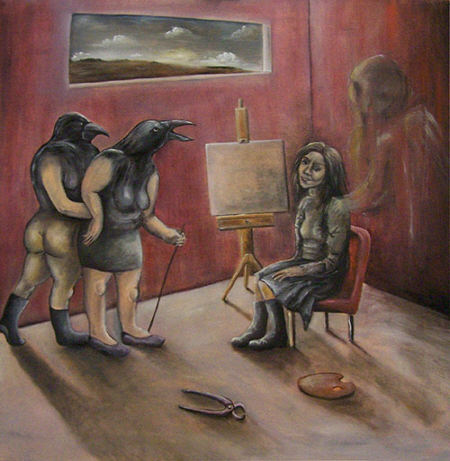
The Verdict, oil on canvas
more… »
Posted by Angela Ferreira on October 28th, 2007
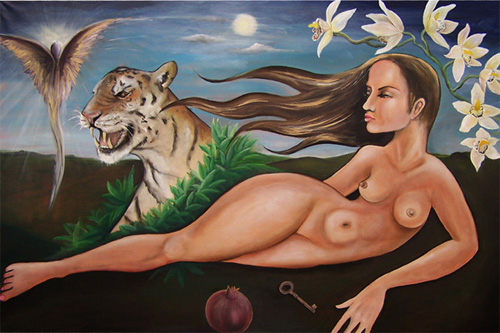
Title: Punica Malum
Medium: Oil on canvas
Size: 78×170 cm
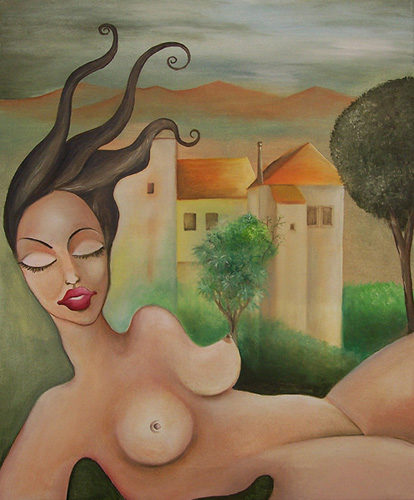
Title: Profanum
Medium: Oil on canvas
Size: 60×45 cm
Posted by Angela Ferreira on September 10th, 2007
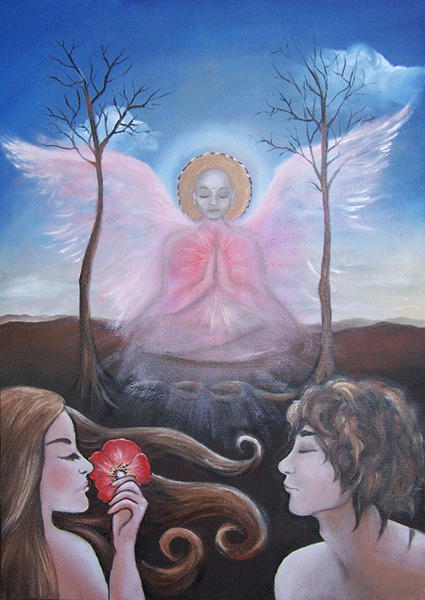
Sitting and meditating lately about what is really life about that makes up get up in the morning and carry on as artists…
Is it how much money you got in the bank? The partner of our dreams? That new car you been saving up? The Exhibition you booked for?
Or is it the peace of mind, security and happiness that all this acquirements provide us?
What is really life about?
It’s very easy to confuse values with goals, but they are very different – goals are specific ways in which you might express your values…
Now, think for yourself, what you really value in your life? You might say “my job”, but then ask yourself “What is your job in the service of?” You might answer “Financial security”. Keep asking the same question “What is financial security in the service of?” Keep on asking the question until can’t find an answer and you have found your value.
Values are what life is about, and it it’s all about happiness. Know your values! Happiness is what makes my life worth for, ask yourself!
Everything else my dear collegues, it will before long turn to dust…
Posted by June Underwood on August 17th, 2007
David Lewis-Williams in The Mind in the Cave and Inside the Neolithic Mind postulates that religion has its origins in hard-wired brain functions he calls “states of altered consciousness.” Among these altered states are the hypnogogic (just prior to and awakening from sleep) as well as states induced by consciously chosen activities, for example, rhythmic dancing, meditation, and persistent highly rhythmical sound patterns. And then there are the other well-known states, whether chosen or inflicted, that alter consciousness — ingestion of psychotropic substances, intense concentration, fatigue, hunger, sensory deprivation, extreme pain, migraine, temporal lobe epilepsy, hyperventilation, electrical stimulation, near-death experiences, and schizophrenia and other pathological conditions (Inside the Neolithic Mind, page 46).
These states of consciousness, combined with homo sapiens’ ability to remember the visions that occur in such states, says Lewis-Williams, account for the rise of religion, some social organizations (primarily religious hierarchies), and the early paintings and art found in western Europe at places like the caves of Lascaux well as in the Near East around the upper reaches of the Tigris-Euphrates, Jordan, and Turkey. more… »
Posted by Karl Zipser on June 18th, 2007

Painting
From Life vs.
From Photos
Cennino Cennini devotes his Il Libro dell’ Arte (late 14th c.) to a practical explanation of the materials and techniques of painting. And yet Cennino also writes of painting as an occupation that deserves “to be crowned with poetry”, because the painter has the ability to compose from the imagination, “presenting to plain sight what does not actually exist.”
 It might seem there is a mismatch between focusing on the physical aspects of the work, and at the same time emphasizing the role of imagination in creating art. But this combination of the mundane and the fanciful is appropriate for a simple reason: an artist creating from the world of the mind must nonetheless work in the world of the materials. The physical nature of those materials, and the way the artist uses them, will inevitably influence how the inner world of the mind is discovered and expressed.
It might seem there is a mismatch between focusing on the physical aspects of the work, and at the same time emphasizing the role of imagination in creating art. But this combination of the mundane and the fanciful is appropriate for a simple reason: an artist creating from the world of the mind must nonetheless work in the world of the materials. The physical nature of those materials, and the way the artist uses them, will inevitably influence how the inner world of the mind is discovered and expressed.
Contemporary artist Hanneke van den Bergh recognizes and makes use of this interplay of the imaginary and the physical in her clay sculpture. She explains “I like to make the heads by moving a little lump of clay until I can just see the face. I like this quality of the imaginary form beginning to emerge from the raw material.” Van den Bergh does not attempt to disguise the properties of her materials. In the example shown here, Danae III, she leaves visible the coils with which she constructs the main form. The contrast of the repeating pattern of coils with the rhythm of the body contributes to the expressive effect of the work. “By avoiding too much detail,” she says, “I maintain the contrast between material — the physical — and the imaginary.”
Posted by June Underwood on May 25th, 2007
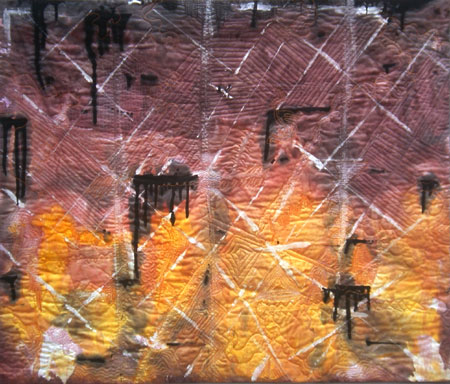
Farmland, 36 x 43, painted cotton
I have lived many places, and in each, I have always had a strong sense of the place itself — the trees and plants, the nature of the cultivated earth, the nature of the uncultivated earth, the sky, winds, air, light — I can describe all these with a fair amount of detail.
But I seldom had to try to recap in art what I know about a place where I no longer live. However, now I am doing so.
“Paint what’s around you,” seems to be a sound admonition, but what is around me is the opposite, environmentally speaking, of what I am painting. more… »
Posted by Angela Ferreira on May 20th, 2007

Title: Give Peace a Chance
Size: 170 x 78 cm
Medium: Oil on Canvas
Description: Art that changes the World!




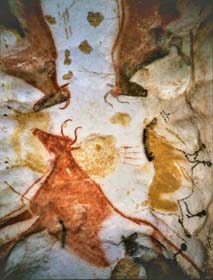

 It might seem there is a mismatch between focusing on the physical aspects of the work, and at the same time emphasizing the role of imagination in creating art. But this combination of the mundane and the fanciful is appropriate for a simple reason: an artist creating from the world of the mind must nonetheless work in the world of the materials. The physical nature of those materials, and the way the artist uses them, will inevitably influence how the inner world of the mind is discovered and expressed.
It might seem there is a mismatch between focusing on the physical aspects of the work, and at the same time emphasizing the role of imagination in creating art. But this combination of the mundane and the fanciful is appropriate for a simple reason: an artist creating from the world of the mind must nonetheless work in the world of the materials. The physical nature of those materials, and the way the artist uses them, will inevitably influence how the inner world of the mind is discovered and expressed.
